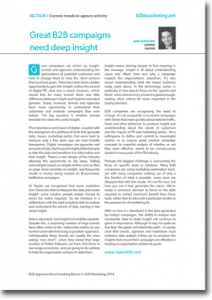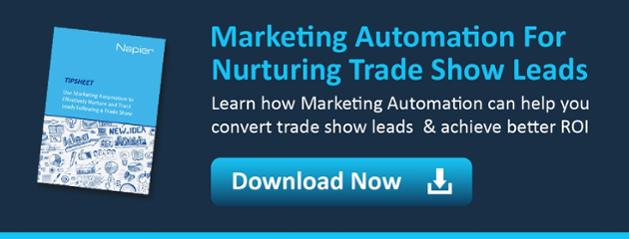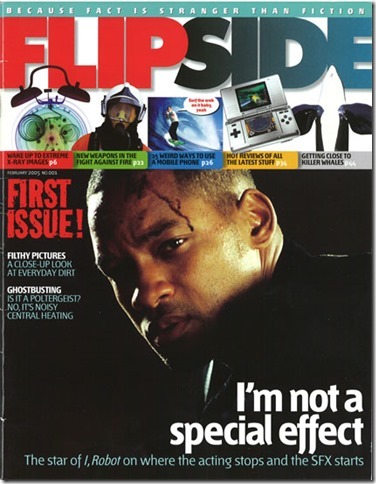Napier Appoints Recent Apprentice as Marketing Specialist

Since starting Napier’s apprenticeship programme in July 2014, Freya has brought bags of enthusiasm and fresh new ideas to the team, and has gained practical industry experience whilst working towards a level 2 NVQ certificate in Marketing at Chichester College. Following the successful completion of this certificate, she is currently undertaking a CIM L4 Certificate in Professional Marketing.
Freya will continue to support the team in a variety of areas, including email marketing, ad production management, media buying and video editing.
Email Rendering on Apple Watch: Are Plain Text Emails the Future?
While the release of the eagerly-awaited Apple watch is finally upon us, it’s left many email marketers and designers questioning how exactly their emails will display on the watches 38mm screen.
While it’s hard to gauge the long-term success of Apple’s latest innovation, email marketers should be aware of how this gadget may impact the future of email campaigns, and subsequently how they should be developing their emails to ensure they display effectively.
Plain text is making a comeback
Should the Apple Watch detect any remote of linked images within the email, it will display a long (full screen) warning; “This message contains elements Apple Watch can’t display. You can read a text version below.” Although the plain text version will be displayed below, the user will have to scroll down to read it. This means that to reach your audience that are opening on an Apple Watch, you must have a plain-text version of the email.
Emails without a plain text version won’t render
Failing to include a plain text version of your email will display the following message, “The full version of this message isn’t available on Apple Watch. But you can read it on your iPhone.” Given the size of the watch, ensure your plain-text version provides condensed and digestible content. What’s interesting, however, is that the name, subject line and pre-header text is pulled from the HTML and displayed.
Links are disabled
It’s important to remember that the Apple Watch hasn’t been designed to browse the internet, and as such any links included in emails will be disabled and displayed in greyed out text. Any displayed addresses, however, will link to Google Maps, and recipients will also be able to click on any displayed phone numbers to make a call. Without the use of links as CTAs, brands should look at alternative ways to create any CTAs.
Opens won’t be tracked
As a result of the watch only displaying plain text emails, marketers won’t be able to track email opens, since tracking opens requires images loading in the recipients inbox. Marketers should instead think of alternative metrics to measure success, while being aware that you may notice a decline in your overall engagement metrics.
Create personal and meaningful emails
The Apple Watch hasn’t been designed to display lengthy html email versions, rather it favours a more personal approach, subsequently making it difficult for brands to engage with their audience via this channel. The challenge is, marketers can’t predict which device their message will display on (or attempt to display on), and therefore must create meaningful plain text emails for each message.
“View on iPhone” replaces “View in Browser”
While it’s not possible to include links in your email, the more the contents of your email is compelling and resonates with your audience, so that they change viewing device to take action.
Real-time triggered messages
While perhaps not entirely relevant to B2B brands, it’s worth acknowledging that the Apple Watch provides some benefits to marketers that otherwise may not be possible. The devices’ geo-fencing feature enables email and SMS notifications to be sent to nearby Apple Watch users, providing brands with a significant opportunity to notify individuals of product information and deals, and guide them into stores.
There is no denying that the arrival of the Apple Watch will impact your email campaigns, but it worth noting that several email service will soon be providing email testing for Apple Watches. If you would like any help implementing a successful email strategy, give us a call today on +44 (0)1243 531123, or send us over an email to mike@napierb2b.com.
Great B2B Campaigns Need Deep Insight
Great campaigns are driven by insight: brands and agencies understanding the perceptions of potential customers and how to change them to help the client achieve their business goals. There has never been a better opportunity to gain this insight: before the advent of digital PR, data was a scarce resource, which meant that for many brands there was little difference between insight and inspired educated guesses. Today, however, brands and agencies have more opportunity to understand their customers and evaluate campaigns than ever before. The big question is whether brands can translate this data into useful insight.
Have a read of our full article on why great B2B campaigns need deep insight, as featured in B2B Marketing’s first PR Agencies Benchmarking Report.
If you need any help implementing an effective B2B campaign that uses deep market insight, give us a call on +44 (0)1243 531123, or send me over an email to mike@napierb2b.com.
Anritsu Appoints Napier to Increase European Presence
Napier has been selected by Japanese test and measurement solutions manufacturer Anritsu, to increase the company’s presence in the European media.
Napier was selected as a result of their experience and expertise in the electronics industry, and will deliver a pan-European PR campaign to raise awareness of the company and its solutions across Europe.
Phil Ling Launches Enginuity Europe
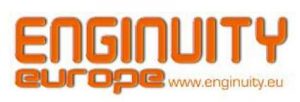
Enginuity Europe’s approach is to combine engineering experience and journalist skills, to conduct hands-on evaluations of technology, creating truly unique content that represents a new era in B2B media.
The publication will allow a mix of editorial content generated by Phil and his team with content generated by suppliers, The site uses clear branding in the editorial videos, which should ensure visitors can immediately recognise independent analysis by the editorial team and differentiate this from the inevitably biased content produced by manufacturers.
It's great to see a new publication launch in Europe, and we really hope that Phil is successful with this venture. Our industry has seen a couple of video-centric sites launch with limited success, and maybe the focus on editorially-produced videos will be the secret that ensures Enginuty Europe is one of the go-to publications for engineers.
Arrow buys Hearst Electronics Group: are distributors the future for publications?
Whilst it appears to have been an open secret that Hearst was keen to offload its technology titles, it does come as a bit of a surprise that Arrow is the company that has stepped in to buy them. Whilst owned media continues to grow in importance, picking up titles such as Electronic Products, EEWeb, and Embedded Developer, as well as databases such as Electronics Engineering Master and a share in the joint venture Chinese site 21ic.com is, by any measure, a bold move.
I'm fascinated to see what happens as a result of the acquisition. It would be great if a distributor such as Arrow could show that it can be a component vendor and a successful publisher. But the acquisition is fraught with a number of possible pitfalls. For example it's hard to see other distributors being as committed to the Stockcheck plugin if it is controlled by a competitor. Maintaining advertising in the publications is likely to be equally challenging, and hard questions could be asked by manufacturers who don't use Arrow as a distributor, as well as competitors. It might even be hard to maintain rates with suppliers that do work with Arrow, as I'm sure many will be keen to use their relationship to negotiate better rates.
Whatever the financial implications, there is always the question about whether distributors can run publications successfully. Whilst most of them offer in-house titles, and have very significant readership, I don't think that any of the distributors has yet been able to produce a title that is as influential as the best independent publications.
Despite these concerns, it's exciting news. Firstly Arrow is a smart organisation, and they will have through through these potential problems. Clearly they believe that the benefit to their organisation will outweigh any possible loss of revenue. More importantly some great titles now have an owner that really wants them: this has to be better than the previous situation: Hearst clearly didn't feel the titles fit with their plan for the business.
it will be interesting to see what does happen in the long term. My guess is that Arrow probably won't want to continue with all the publications - hopefully those they don't want will get sold or spun off, rather than be closed. I do, however, think that there is a good chance that Arrow will make a success of the acqusition: providing some element of editorial impartiality remains, they should be more than able to grow the audience for the titles, and there are obvious benefits to a distributor like Arrow in having such influential titles batting on your side.
Dr. Dobbs to close. Is this the end of the (B2B publishing) world?
I shouldn't be shocked by publications closing: there have been so many good titles fall by the wayside recently. But Dr. Dobbs? How can UBM possibly have made the decision to close it? (If you've never been involved in software development, just ask an engineer to find out how highly this publication is valued).
Dr. Dobbs has been the software development publication for a long time. The title started 38 years ago, and I remember the fights over who got to read the magazine when I first began work as an engineer. It is clearly still well-loved, with over 10 million page views a month and more than 10% traffic growth year-on-year, yet UBM has decided that it won't be able to make money from the site in the future (although according to the announcement about the closure it is still profitable).
So who is to blame? Andrew Binstock, editor in chief of Dr. Dobbs lays the blame firmly at the door of the advertisers:
Four years ago, when I came to Dr. Dobb's, we had healthy profits and revenue, almost all of it from advertising. Despite our excellent growth on the editorial side, our revenue declined such that today it's barely 30% of what it was when I started. While some of this drop is undoubtedly due to turnover in our sales staff, even if the staff had been stable and executed perfectly, revenue would be much the same and future prospects would surely point to upcoming losses.
Andrew then seems to dismiss all online advertising, saying that:
This is because in the last 18 months, there has been a marked shift in how vendors value website advertising. They've come to realize that website ads tend to be less effective than they once were. Given that I've never bought a single item by clicking on an ad on a website, this conclusion seems correct in the small.
Whilst the effectiveness of online display advertising has clearly waned in recent years, there are obviously many cases of people buying after clicking a banner. And don't forget that one of the main reasons for the fall in click-through rates is the proliferation of adverts on every page, as publishers try to maximise the revenue they can achieve using their familiar cost-per-impression model, rather than trying to deliver value to advertisers. To be fair, the page announcing the closure of Dr. Dobbs has a rather modest three display slots, although it also features 10 paid-for links to content (with a link explaining they are advertising), six links to pages that allow you to register for more paid-for content, and so many links to other content on the side that I couldn't face trying to count them.
Of course it's not just an issue of advertising spend - competition from other publications has eaten into the total budget. Stack overflow, which has proved that user-generated content can be both low cost and high quality seems to be going from strength to strength.
Despite the reality of the situation, one major frustration remains. Why does UBM insist on closing this much-loved publication? Dr. Dobbs is profitable. Andrew even outlines a business plan he believes will ensure the long-term profitability of the title. But UBM doesn't want to run the small events that would ensure profitability and doesn't want anyone else to make a success of the publication. Whilst it's not clear that this will be the case, it must be inevitable that good journalists will lose their jobs because of this decision. Of course UBM, and other publishers, have every right to do what they want with the publications they own. It would be fabulous, however, if large publishers could find a way to allow titles that could be profitable to continue publishing by selling them to smaller publishers who can build a business model that works. Reed managed to do this recently with Electronics Weekly, which seems to be thriving within Metropolis, although sadly it's not just UBM who closes titles: Reed chose not to sell EPN, despite there being interested buyers.
Perhaps the reality of the situation is that large publishers are simply not the right place for B2B trade titles to thrive. It's true that for a company the size of UBM, a site with 10M page views a month is not a significant part of their business. Let's hope that some of the smaller, leaner and more entrepreneurial publishers will see this as an opportunity, and will launch sites that not only fill the gap left by Dr. Dobbs, but also make a decent profit.
Our new apprentice - Bryn

With my Welsh blood, you’d never guess with a name like Bryn, I'm into rugby and have been playing for my local team since I was 10. I like to give back to the community and have begun to journey to becoming a coach.
In the first few weeks at Napier I will be getting involved researching and updating our internal systems with 2015 publisher data for features, webinars and events. In the New Year I’m hoping to become more involved in supporting the team on client work.
I live locally in Portsmouth and chose to take an marketing apprenticeship over going to university because Napier offered me on the job learning and a chance to develop my skills in marketing. Music is my other passion, and I’m a bit of a one man band having learnt to play the saxophone, guitar, drums and keyboard. If I am not laying down my own music, you can find me at the decks DJ’ing (that's me on the right) for friends and charities.
PCIM South America 2014 attracts around 300 experts
Around 300 specialists attended PCIM South America from 14 – 15 October 2014 in São Paulo, Brazil, to find out more about trends and current applications and solutions within power electronics.
The key topics of the conference concentrated on applications for electrical vehicles, requirements for power converters and solutions regarding electrical drives. During the four keynotes, seven oral and two poster sessions specialists came together for extensive discussions. In addition to the conference four seminars held by international experts, offered a unique educational opportunity in Brazil.
At the accompanying exhibition leading companies presented their new products and solutions for the Brazilian market to an audience of users and scientists.
Whilst 300 attendees isn't huge, particularly when you compare it with the German show, it does demonstrate that there is a strong electronics industry in South America, and I am sure we will see this emerging event go from strength to strength over the next few years.
EMC Live 2014
EMC LIVE is a brand new, online three day event hosted by Interference Technology. Featuring practical information and topics, this event will include roundtables, webinars and videos on everything EMC-related, and there’s no cost to attend. It’s happening on 14th to 16th October 2014.
This will be a great event targeted at electronic, mechanical, and design engineers who are looking to improve their practical knowledge in the field of electromagnetic interference and compatibility.
Make sure to register for the EMC LIVE event.
Napier wins Imagination Technologies campaign

Napier was selected as a result of our experience and expertise in the electronics industry. Imagination is one of the most exciting technology companies in the world, a British success story that provides processors and other technology that powers a vast range of products including mobile phones, complex industrial systems and devices connected to the Internet of Things (IoT).
The top factors determining Google search ranking in 2014?

Overall, the presence of relevant words on a page (i.e., not just an exact match with the search term) has the strongest correlation with positive search rank. Social signals (Google +1s, Facebook shares, Pinterest pins, tweets, etc.) also tend to have very positive impact on search rank, as does the number of backlinks.
Google has been tying rank on search engine results pages (SERPs) to content quality for years, and the analysis found this trend accelerated significantly with the Hummingbird algorithm update last fall.
The report also found that Google does not seem to favor pages that meet certain traditional SEO criteria, such as fast load times and short URLs; rather, it is the absence of those criteria that seems have a negative effect on the ranking. When it comes to keywords in a site's domain/URL has dropped from being positively correlated with search rank in 2012 to now being zero/slightly negatively correlated.
View the report outline.
Introducing the new electronics Spanish magazine
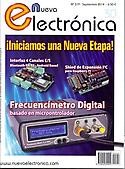
More specifically, the magazine is geared towards those who work in Research and Development labs and Technical Departments of small and medium sized companies, as well as those still attending courses in electronics and computer science, from high school to university students, and their teachers.
Facebook’s click-bait crackdown: implications for marketers
Facebook has announced adjustments to the way in which users see articles on its site, reducing stories with click-bait headlines - posts that tempt readers with beguiling headlines, yet deliver content that is actually of very little interest to the reader.
Despite these “click-bait” headlines once being favoured by the algorithm, because they are frequently shared, Facebook has more recently found that 80% of users prefer headlines which help them decide if they want to read the full article prior to clicking through. In fact anecdotal evidence suggests many of the users sharing these links didn’t actually read the story.
While this move intends to crackdown on these often misleading tactics, in a bid to enhance the user experience, it is likely to have a direct impact on genuine media in terms of hits. The revamped algorithm will now consider both the length of time users spend reading an article, as well as the number of users who comment or share the article, as a way to determine its importance. It will make the assumption that if a user clicks through and spends time reading the article, then it is in fact of value, and subsequently worth a higher ranking. The problem with this, however, is that it fails to recognise that not all readers will spend substantial time consuming content, despite potentially being of value, after all it may be a short or visual story, or there may be in fact be user distractions. Oh and there’s also the problem that many people don’t tend to share, like or comment on stories.
So while users may be relieved of spammy and misleading ads, companies or journalists that continue to post links with click-bait headlines (genuine or not), which fail to retain the reader’s attention for a significant period of time, will start to see a decrease in click-through rates.
For marketers who haven’t already, perhaps now is the time to employ new strategies for content creation and distribution across certain social media channels, look at ways to provoke emotion through content in order to encourage shares and comments, and finally realise that click-through rates aren’t always a good measure of quality, particularly when it comes to advertising.
National Electronics Week and Vehicle Electronics Magazine
Vehicle Electronics Magazine has joined as a partner at National Electronics Week and will be providing a conference within the Embedded and Software Zone.
The conference will look specifically at ‘Driver Assistance and the Move towards Autonomous Vehicles’ in the Embedded and Software zone as part of next year’s National Electronics Week in Birmingham, UK. The conference will comprise two half-day events on Tuesday and Wednesday the 21st and 22nd of April 2015 at the NEC in Birmingham.
Make sure to register for next year’s event
PSD launches German language multimedia content

You can view the German Multimedia department here.
Twitter launches performance-based tool aimed at SMBs: Possible implications for B2B publishers?

This performance-based tool has specifically been introduced to help SMBs meet their campaign objectives on the platform, and promises to help advertisers create and optimise marketing campaigns, by enabling them to only pay for the actions that meet their objectives, whether this be to drive followers, website clicks or conversions, tweet engagements, app installs, engagements or leads.
With SMBs typically having smaller budgets, this tool could be particularly beneficial as it will allow for a much more focused approach to advertising efforts, potentially providing them a better understanding of how to create and optimise campaigns in order to maximise their ROI. While this is a huge benefit to advertisers, it could in fact present a potential problem for B2B publishers. If more platforms migrate towards this cost-per-action based charge, there is the risk that B2B publishers won’t be able to compete on price with social media networks, something could potentially ruin their ability to claim a much higher cost-per-impression than other platforms.
Embedded Masterclass returns to NEC in 2014
After joining forces with National Electronics Week 2014, Embedded Masterclass will return to the NEC with National Electronics Week 2015 from 21st-22nd April.
Embedded Masterclass is a dedicated engineering design conference for the embedded community. The 2015 event will grow on the first year's performance by offering to create a strong marketing platform for electronics engineers to meet key buyers and service providers.
National Electronics Week 2014 saw over 4300 visitors come through the doors over the three days of the event, and with several of those visitors stating that their primary area of interest was embedded.
Bringing the events together will help delegates make the best use of their time away from the office, giving a fantastic opportunity to learn and engage with key industry experts in one arena.
Are technology journalists facing extinction?
Dave Lee, Technology reporter for the BBC, recently wrote a blog post named “Technology journalists are facing extinction”. Throughout the post he raises concerns about the lack of need for his job and technology journalists.
He looks several case studies where technology journalists are no longer being used. One case study he views at is the Edward Snowden revelations. He looks at how the story was broken, not by a technology writer, but by a civil rights specialist with a background in law.
Although he comes from a technical background he is finding others are being used for technology inputs. He believes that technology journalists are to survive, there should be two distinct sides. One looking at the “geekiest aspects” including new chips and R&D. And the other working with trade press.
The post is a very interesting read and raises relevant points that raise the question of the importance for technology journalists.
LinkedIn slashes referral traffic to publishers
LinkedIn risks alienating top publishers in the world of business news, some of whom used to rely on the social network for a chunk of their traffic.
In its bid to become a content platform in its own right, LinkedIn seems to have cut out some of the big publishers that rely on it for referral traffic. Referral traffic from LinkedIn began to lessen back in January and then plunged steeply in March according to a LinkedIn employee and is supported by data.
LinkedIn has spent the past few years attempting to become the definitive professional publishing platform for business content. The changes seem to have started in November when LinkedIn began to implement features of Pulse, a newsreader company it purchased in spring 2013.
These changes that LinkedIn are implementing risk alienating top publishers in the world of business news, some of whom used to rely on the social network for a healthy chunk of their traffic. LinkedIn wants to be an everyday destination for its users, not just a place they come to check out resumes. The true test won’t be whether it can get people to read its content, it is if the content is strong enough to keep users coming back for more.
Call for papers – Smart Systems Integration 2015
The organisers of Smart Systems Integration (SSI) 2015, which will be held in Copenhagen, Denmark from 11th to 12th March 2015, have issued a call for papers. Submissions are invited in a variety of categories. Applications that can be addressed in papers include:
- Smart mobility
- Smart health
- Smart energy
- Smart society
- Smart production
The other categories for papers include hardware/technologies, software for smart integrated systems and smart networking.
Weka to publish official show daily for SPS IPC Drives 2014
The official show daily for SPS IPC Drives will be published by the editorial teams from Weka titles Computer&AUTOMATION, Elektronik and Markt&Technik. It’s great to see Weka again supporting this event, which will be held from 25th to 27th November, especially in an electronica year, which places even greater demands on the journalists during that month.
Elektronik automotive to stage two events on 24 September 2014
On 24th September 2014, Elektronik automotive will stage two parallel congresses at the Landshut University in Germany: the Wiring Harness Congress and the Automotive Software Congress. The magazine will also publish a special issue focussed on Wiring Harness and Vehicle Electrical Systems on September 19th.
The events will address a variety of automotive topics, including:
- E/E architecture and onboard electrical wiring topology
- Internal and external vehicle networking (Car2X)
- Onboard wiring components, materials and processes
- Software development for control units
- Software test and verification
- Software safety
There will also be a table-top exhibition running alongside these events.
Elektra Awards 2014 deadline slips to 11th July
Nice to see some consistency – the traditional extension of the Elektra Awards deadline means that this year you don’t need to get your entries in until Friday 11th July. Good luck!
IET to close Flipside
Sadly the IET has decided to close its magazine for teenagers, Flipside. The last issue will be out in early July.
This is disappointing news. Although it is clearly difficult for an organisation to keep such a publication running – I’m sure they probably made a loss from it – I hate to see publications disappear, particularly when they are designed to get young people interested in engineering.
Dickon Ross also pointed out on his blog that, “Flipside was the first proper magazine after comics for many young teenagers and may even have got them into the reading habit.”
Goodbye Flipside. I’ll miss the peace and quiet I got when my boys were reading a copy…

